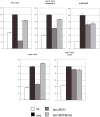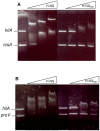Differential regulation of horizontally acquired and core genome genes by the bacterial modulator H-NS
- PMID: 19521501
- PMCID: PMC2686267
- DOI: 10.1371/journal.pgen.1000513
Differential regulation of horizontally acquired and core genome genes by the bacterial modulator H-NS
Abstract
Horizontal acquisition of DNA by bacteria dramatically increases genetic diversity and hence successful bacterial colonization of several niches, including the human host. A relevant issue is how this newly acquired DNA interacts and integrates in the regulatory networks of the bacterial cell. The global modulator H-NS targets both core genome and HGT genes and silences gene expression in response to external stimuli such as osmolarity and temperature. Here we provide evidence that H-NS discriminates and differentially modulates core and HGT DNA. As an example of this, plasmid R27-encoded H-NS protein has evolved to selectively silence HGT genes and does not interfere with core genome regulation. In turn, differential regulation of both gene lineages by resident chromosomal H-NS requires a helper protein: the Hha protein. Tight silencing of HGT DNA is accomplished by H-NS-Hha complexes. In contrast, core genes are modulated by H-NS homoligomers. Remarkably, the presence of Hha-like proteins is restricted to the Enterobacteriaceae. In addition, conjugative plasmids encoding H-NS variants have hitherto been isolated only from members of the family. Thus, the H-NS system in enteric bacteria presents unique evolutionary features. The capacity to selectively discriminate between core and HGT DNA may help to maintain horizontally transmitted DNA in silent form and may give these bacteria a competitive advantage in adapting to new environments, including host colonization.
Conflict of interest statement
The authors have declared that no competing interests exist.
Figures



References
-
- Dorman CJ. H-NS: a universal regulator for a dynamic genome. Nat Rew Microbiol. 2004;2:391–400. - PubMed
-
- Rimsky S. Structure of the histone-like protein H-NS and its role in regulation and genome superstructure. Curr Opin Microbiol. 2004;7:109–114. - PubMed
-
- Falconi M, Colonna B, Prosseda G, Micheli G, Gualerzi CO. Thermoregulation of Shigella and Escherichia coli EIEC pathogenicity. A temperature-dependent structural transition of DNA modulates accesibility of the virF promoter to transcriptional repressor H-NS. EMBO J. 1998;17:7033–7043. - PMC - PubMed
-
- Dorman CJ, Deighan P. Regulation of gene expression by histone-like proteins in bacteria. Curr Opin Genet Dev. 2003;13:179–184. - PubMed
Publication types
MeSH terms
Substances
LinkOut - more resources
Full Text Sources
Research Materials
Miscellaneous

